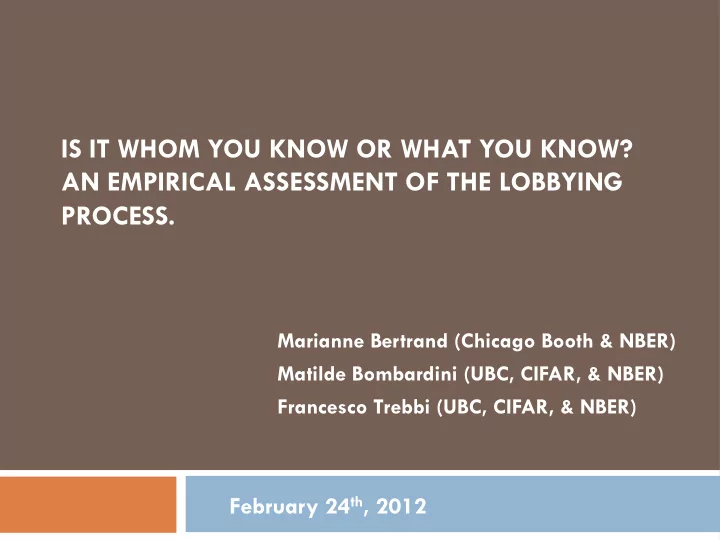

IS IT WHOM YOU KNOW OR WHAT YOU KNOW? AN EMPIRICAL ASSESSMENT OF THE LOBBYING PROCESS. Marianne Bertrand (Chicago Booth & NBER) Matilde Bombardini (UBC, CIFAR, & NBER) Francesco Trebbi (UBC, CIFAR, & NBER) February 24 th , 2012
Motivation ! Lobbying is a large and rapidly growing industry, sitting at the intersection between the economic and political spheres of society. Total US Federal Lobbying Spending ($ billions) 3.5 3 2.5 2 1.5 1996 1998 2000 2002 2004 2006 2008 2010 Year Source: CRP. Note: 2010 data incomplete
Motivation No Systematic Empirical Evidence On What Lobbyists Do " Provide issue-specific expertise ! This is the view maintained by the American League of Lobbyists. ! Nicholas Allard, partner at Patton Boggs LLP: # “I would not – and you would not – try to do a root canal on ourselves. And, that you turn to an expert [a dentist]. And so, put in those terms, the reason why people have expert advocates – or lobbyists- is that you need expertise.” " Exploit relationships and access to political friends ! McGrath (2006): # “There are three important things to know about lobbying: contacts, contacts, contacts. ”
What This Paper Does ! Propose measures/proxies for individual lobbyists’ expertise and connections. ! Compare wage premium for expert/non-expert lobbyists; connected/non- connected lobbyists. ! Develop a test to demonstrate the key role of connections: ! When politicians switch committee (and topics), do lobbyists previously connected to them switch topics as well?
Key Data Source: Lobbying Records ! Lobbying Disclosure Act (LDA) of 1995 ! Requires registration with the Secretary of the Senate and the Clerk of the House of Representatives (appropriate congressional officials) by any individual lobbyist that makes, or is employed or retained to make, a lobbying contact with either the President, the Vice President, a Member of Congress, or any other specified Federal officer or employee. ! Lobbying reports received, processed and maintained for public inspections by the Senate Office of Public Records ( SOPR ). ! Use data for the period 1999 to 2008. ! The entire federal lobbying industry (as officially reported).
Client Amount Date
Issues Names of Lobbyists
Expertise LDA reports allow us to construct measures of issue specialization for each individual lobbyist . ! Define a “ specialist ” (0/1 variable) as someone that Lobbying Issue spends at least ! of his time (measured in $ terms) each year on the same issue.
Connections ! No available data source that systematically maps all the contacts/relationships between lobbyists & politicians. ! Various pieces of investigative journalism offer such mappings for a few individuals (lobbyists & legislators). ! Proxy for such relationships using information of individual campaign contributions made by lobbyists to politicians ( FEC ). ! Cross-match SOPR to FEC based on: lobbyists’ name, employer, address. ! Match FEC data back to legislators ! More than 144,000 individual political contributions by lobbyists.
!"#$% &'(()*+,%-./'0*12"0%2'+3401+,5% &*+6%7'%8'$9+$:% /'0*12"0%;'+7:*(41'+3<% !"#$%&'()*+"%,' -./*0,'1+0%$"2%"3'4%*)5+"6' 7+".52%'!66+8/)3%9:$/%"#' =>?% ;/**'<)=+"' !>/"'1?2@' 7+".52%'!66+8/)3%9:$/%"#' A-' ;$/)"'1)63+"' 1*+0%$'<)$>'1$+?@' :+$2%$'!/#%' A-' ;$?8%'1)3%6' !*3$/)' 7+".52%'!66+8/)3%9:$/%"#' =>?% B/$>'C)"'B+".%"' A)3*'!66"'+D'EF+*%6)*%'B/63$/G?3+$6' 7+".52%'!66+8/)3%9:$/%"#' A-' B+")*#'B)""%$' A)3*':%#'+D'H"#%@%"#%"3';?6/"%66' 7+".52%'!66+8/)3%9:$/%"#' A-' 1)$,'!"#$%6' B?3>+'E+$*#&/#%' 7+".52%'!66+8/)3%9:$/%"#' =>?% 1$%.'()?$%$' I<J' :+$2%$'!/#%' =>?% K)2%6';+*)"#' J?"#L?/63'!"3F+",'77M' 7+".52%'!66+8/)3%9:$/%"#' =>?% K+F"':/6F' 4%,"+*#6'!2%$/8)"' :+$2%$'!/#%' =>?% N%0/"'()##%"' K/2'B,>%'O'!66+8/)3%6P' :+$2%$'!/#%' A-' ()$8'7)2@>/"' Q?/""'1/**%6@/%'O'!66+8/)3%6' :+$2%$'!/#%' A-' ()$>'H6)>+&/3R' :/%$8%S'H6)>+&/3R')"#';*)*+8>' 7+".52%'!66+8/)3%9:$/%"#' =>?% (/8F)%*';+*)"#' B+2%'!#0/6+$6P' 7+".52%'!66+8/)3%9:$/%"#' =>?% A/8F+*)6'TU'M)*/+' M/5.$+?@' 7+".52%'!66+8/)3%9:$/%"#' =>?% 4+G%$3'J8F%**F)6' M/5.$+?@' :+$2%$'!/#%' =>?% J)2'1%#?*#/.' M*)$>'7,3*%'O'1%#?*#/.'' :+$2%$'!/#%' A-' J)2?%*'KU';)@563)' VF%';)@563)'1$+?@' 7+".52%'!66+8/)3%9:$/%"#' =>?% J?%'!"#$%6' I"/+"'<)8/W8' 7+".52%'!66+8/)3%9:$/%"#' A-' V%$%6)':/6F' T*%83$+"/8'H"#?63$/%6'!**/)"8%' :+$2%$'!/#%' A-' V%$$,'X+*3' XB(N' :+$2%$'!/#%' A-'
Lobbyists’ Wage Premium: Expert vs. Non-Expert
Lobbyists’ Wage Premium: Connected vs. Non-Connected
Political Cycles in Wage Premium Republican lobbying revenue premium (per lobbyist) .4 .3 .2 At peak of GOP power: .1 +25% yearly 0 premium for GOP lobbyists -.1 1998 2000 2002 2004 2006 2008 2010 Year % GOP Revenue premium 5% Confidence band Democratic Benchmark Congress White House
A More Formal Test ! Exploit committee reassignments: as politician moves to new topic do lobbyists: ! Follow the politician? (Connections) ! Continue lobbying on the same issue? (Expertise) ! Consider committee “switchers” and form all possible switcher-lobbyist pairs ! Some pairs are connected by a campaign contribution, some are not ! Create issue overlap of new topics between switchers and lobbyists ! Question: is new issue overlap higher for connected pairs than for non- connected pairs (control group)
Issue Overlap: Example Senator seats on the REL ECN FOR Foreign Relations Committee at t FOR AGG TOB Lobbyist at t Overlap = 1
Table 6: Do Lobbyists Follow Politicians? Dependent Variable: Number of new issues for the legislator in Congress (t+1) that the Lobbyists covers in Congress (t+1) (1) (2) (3) (4) (5) (6) (7) (8) Lobbyists made at least one campaign contribution to that Congressman in Congress ( t )? (Y=1) 0.359 0.342 0.118 0.201 0.188 0.100 0.106 0.306 [0.046]** [0.047]** [0.043]** [0.046]** [0.044]** [0.033]** [0.033]** [0.057]** A connection implies an overlap increase of about 30%. L follows P’s to which he’s connected.
Recommend
More recommend